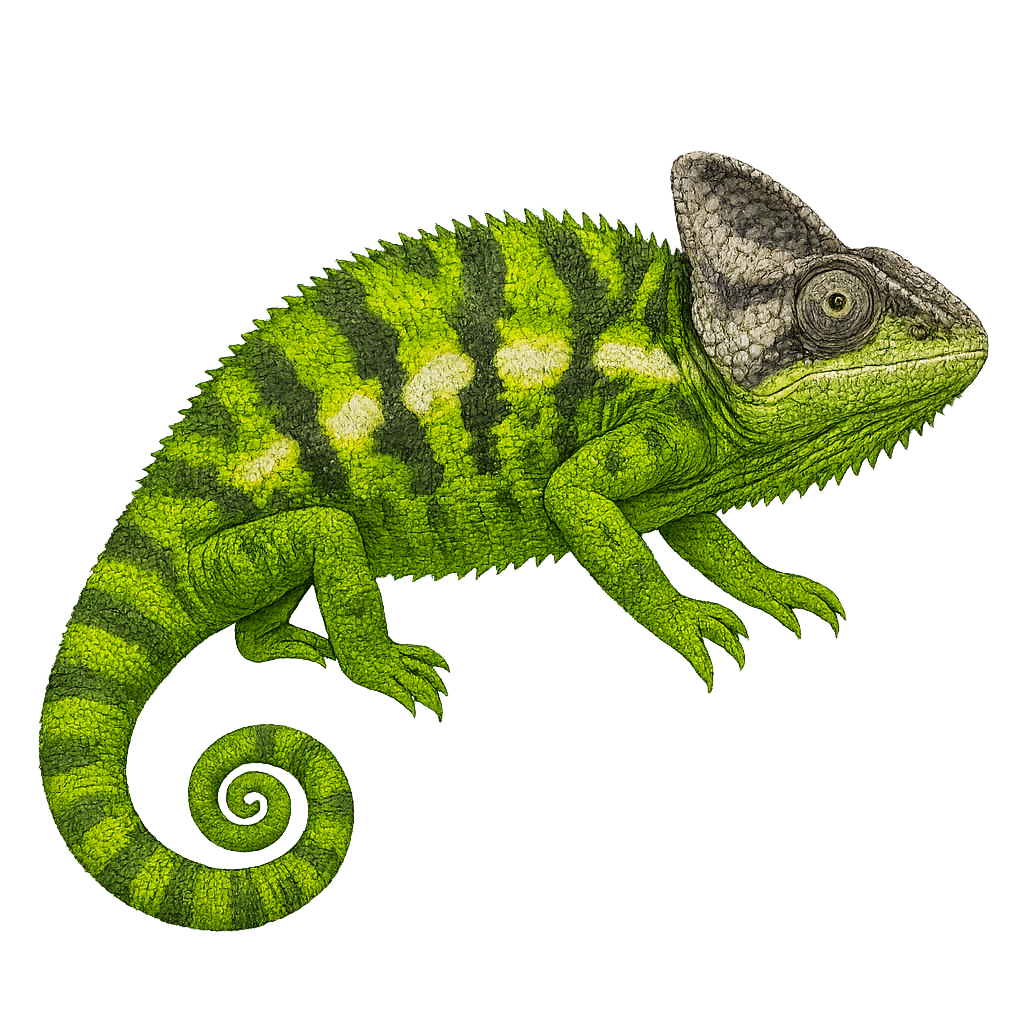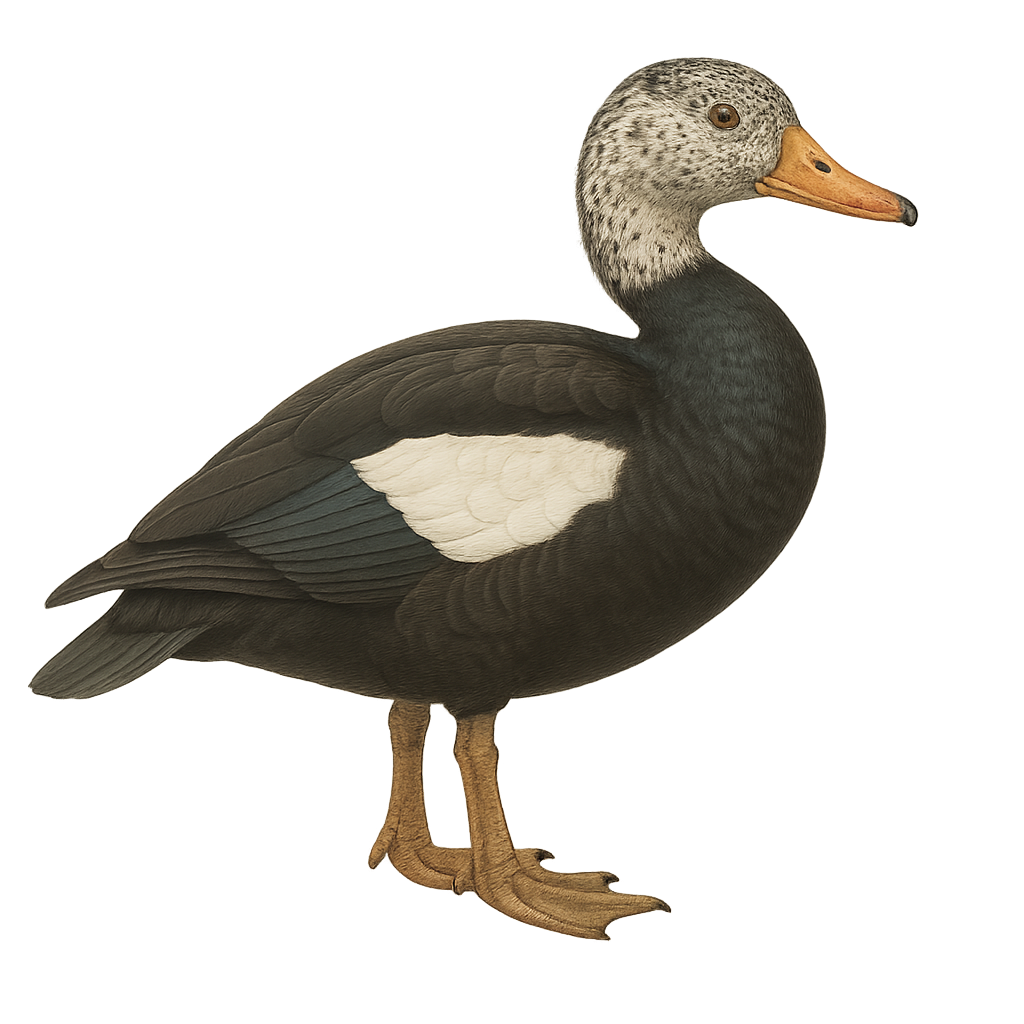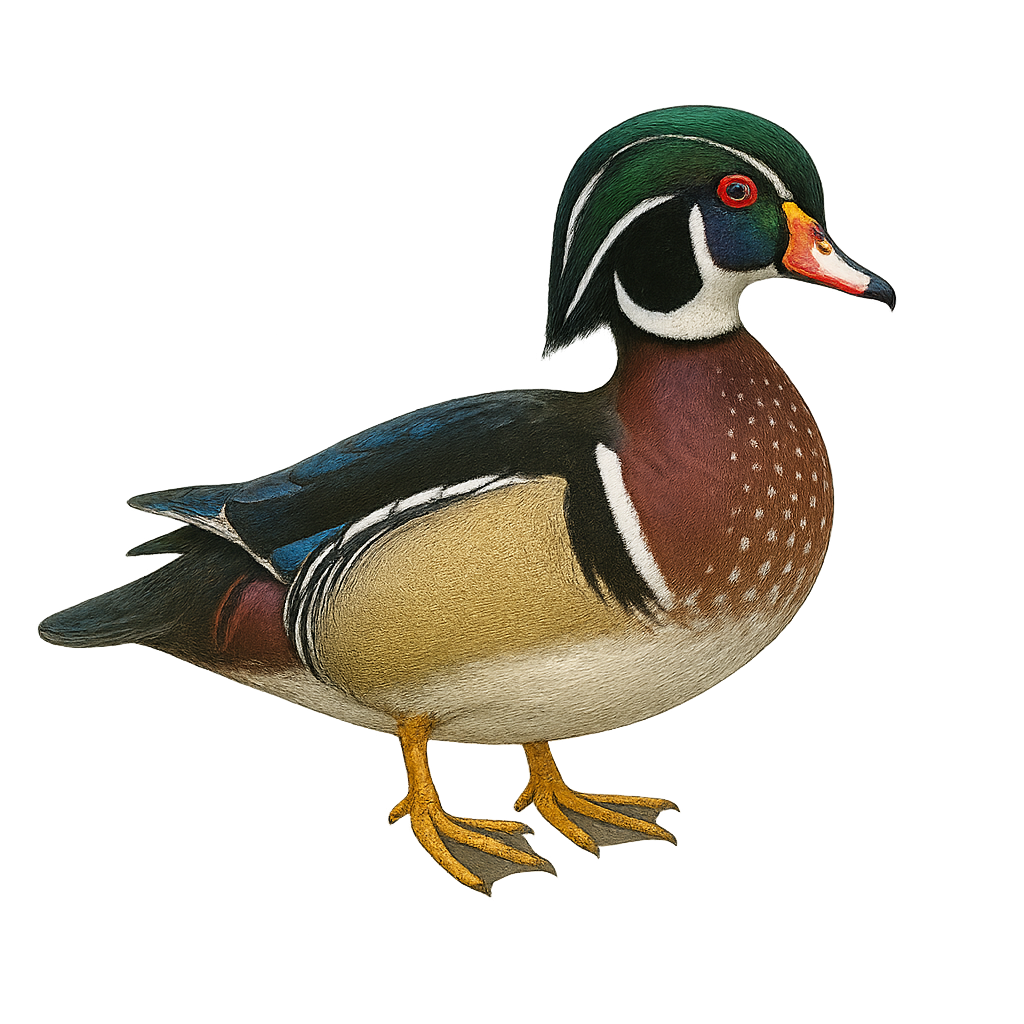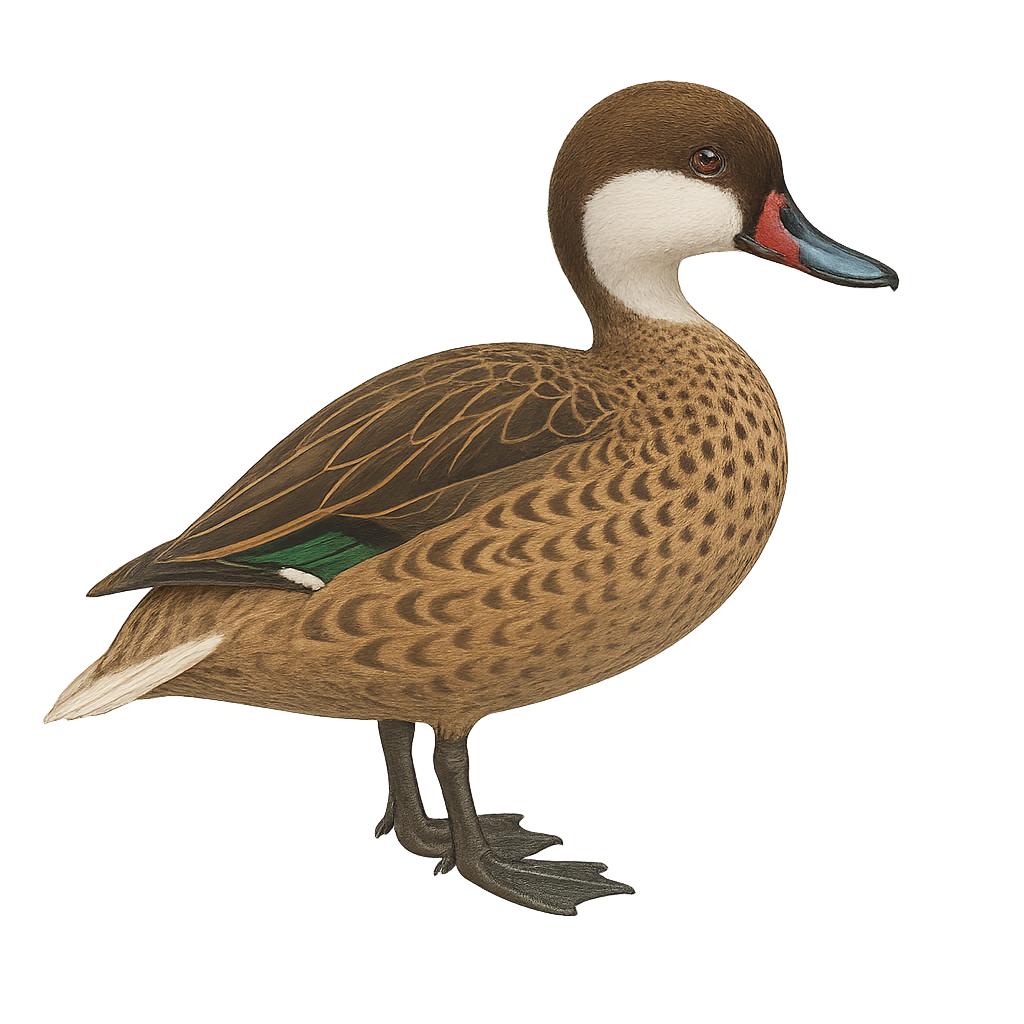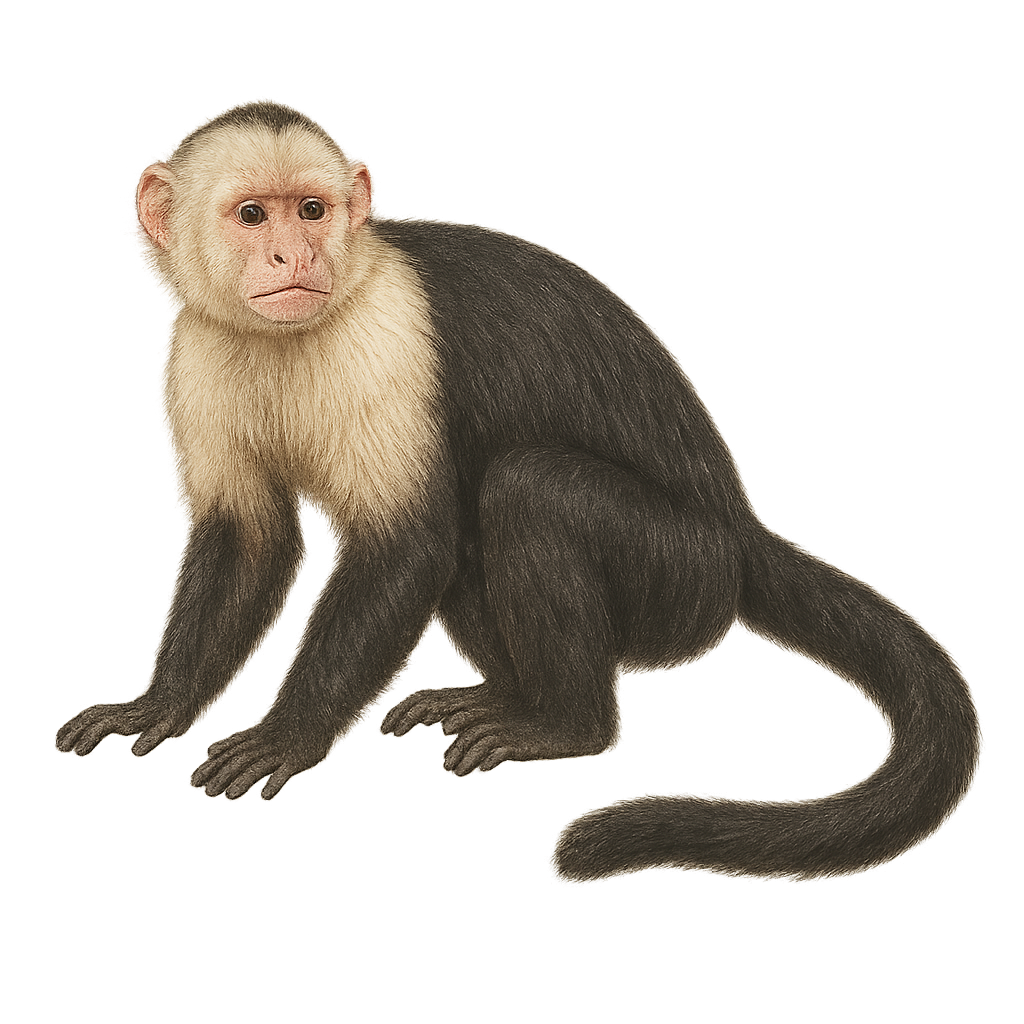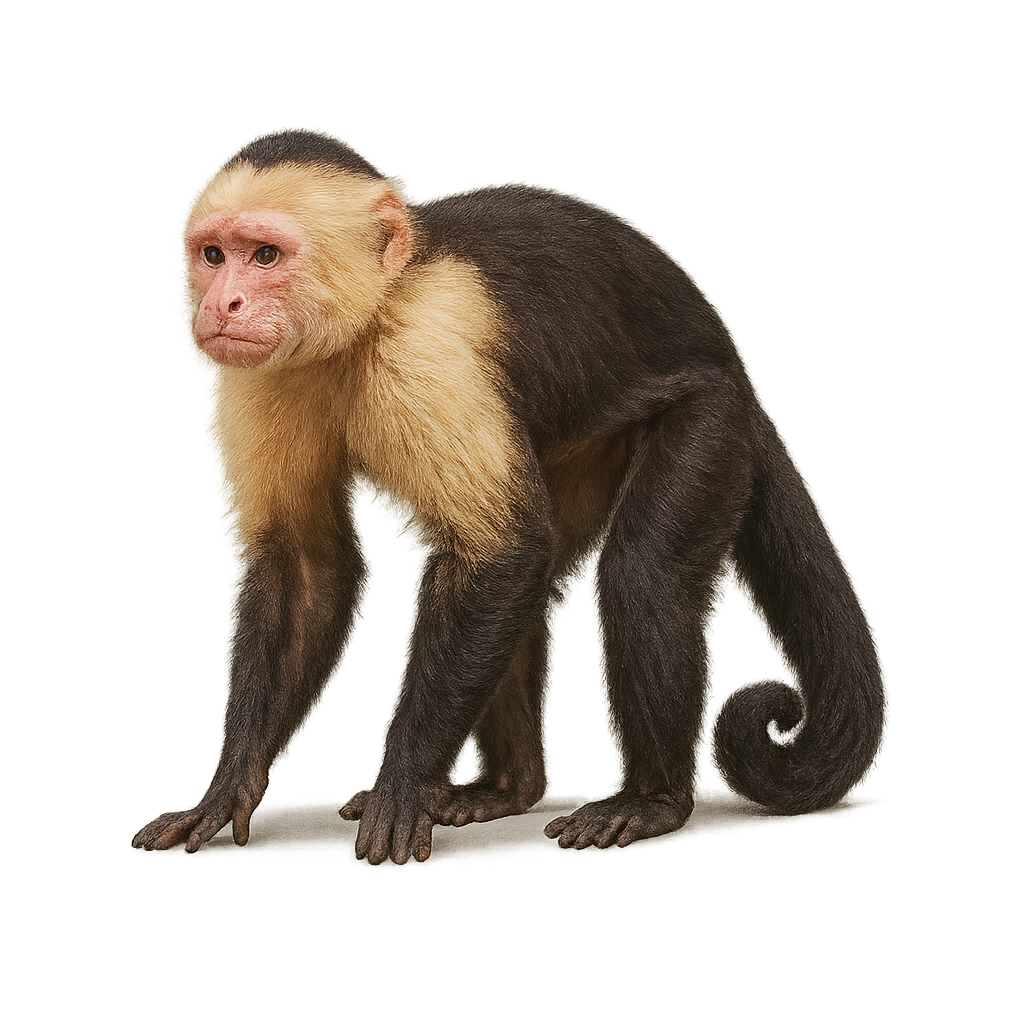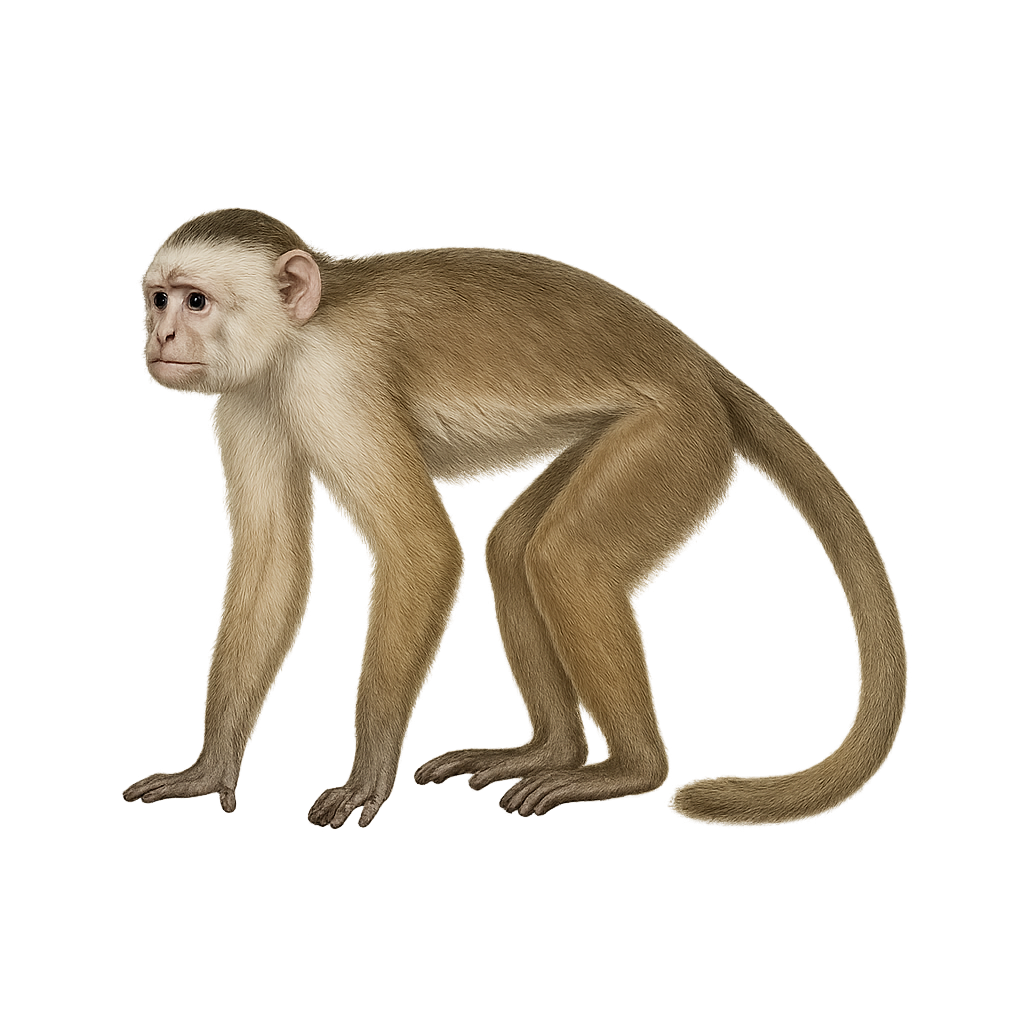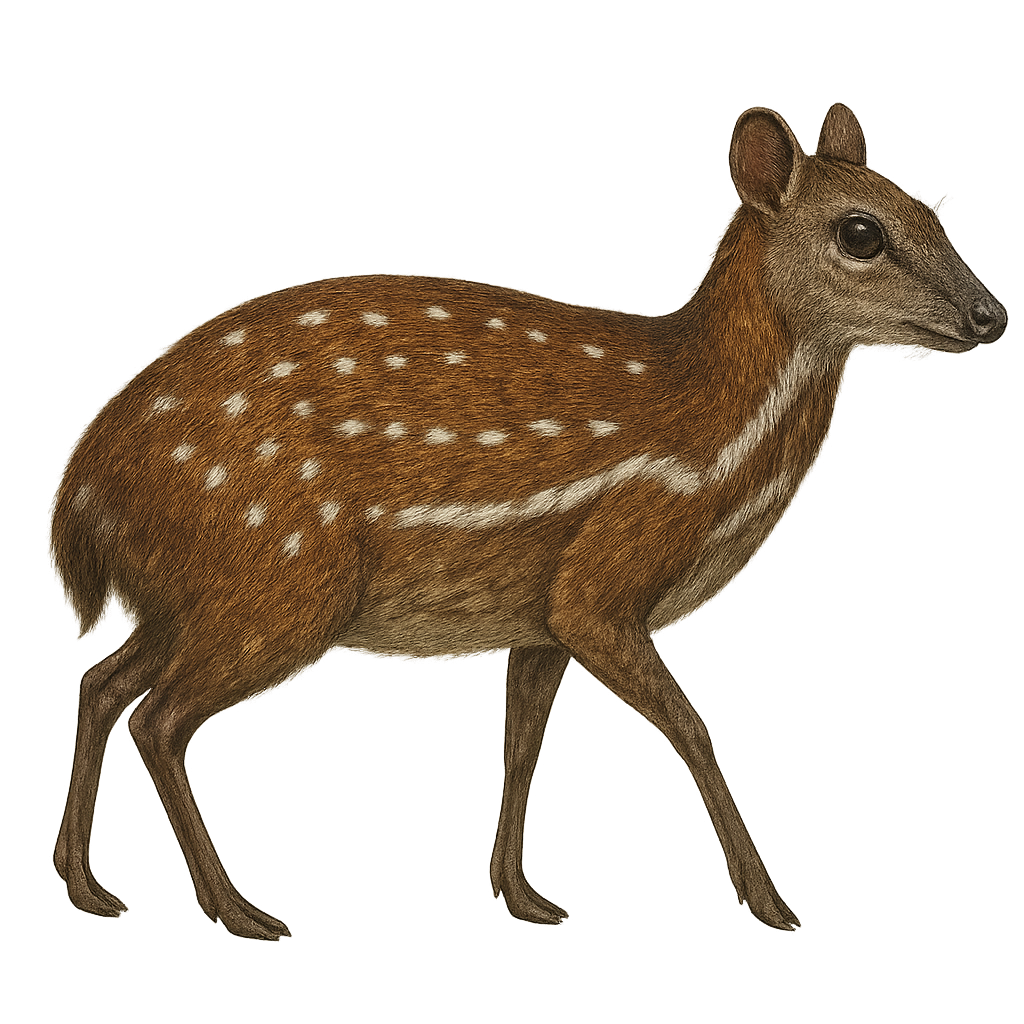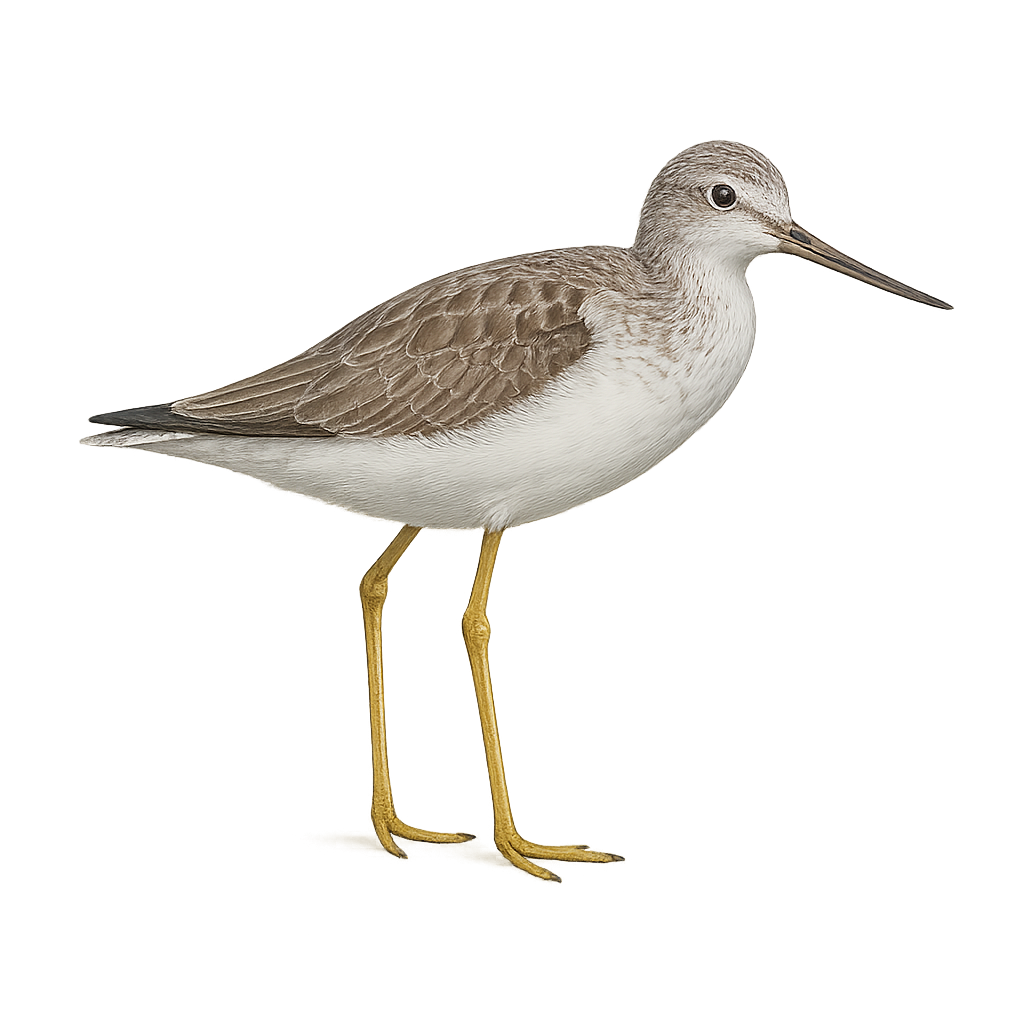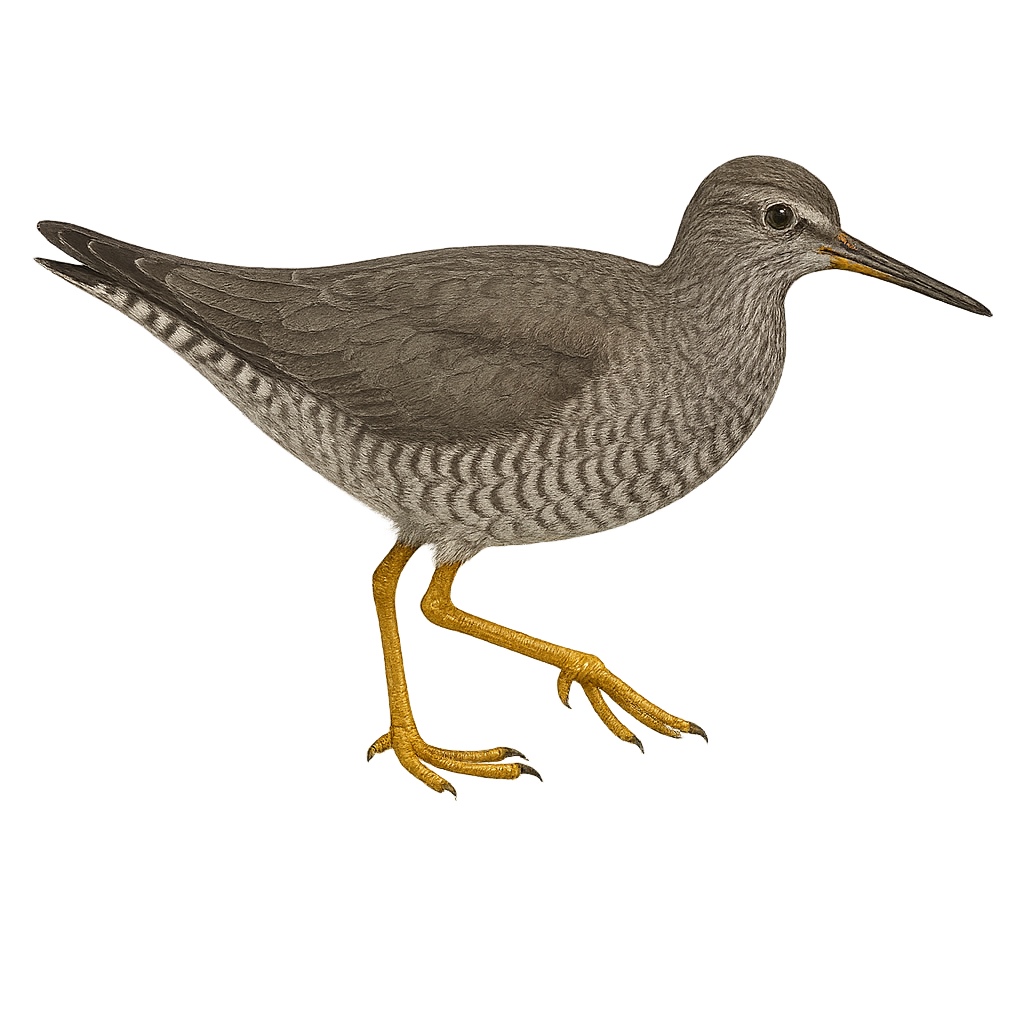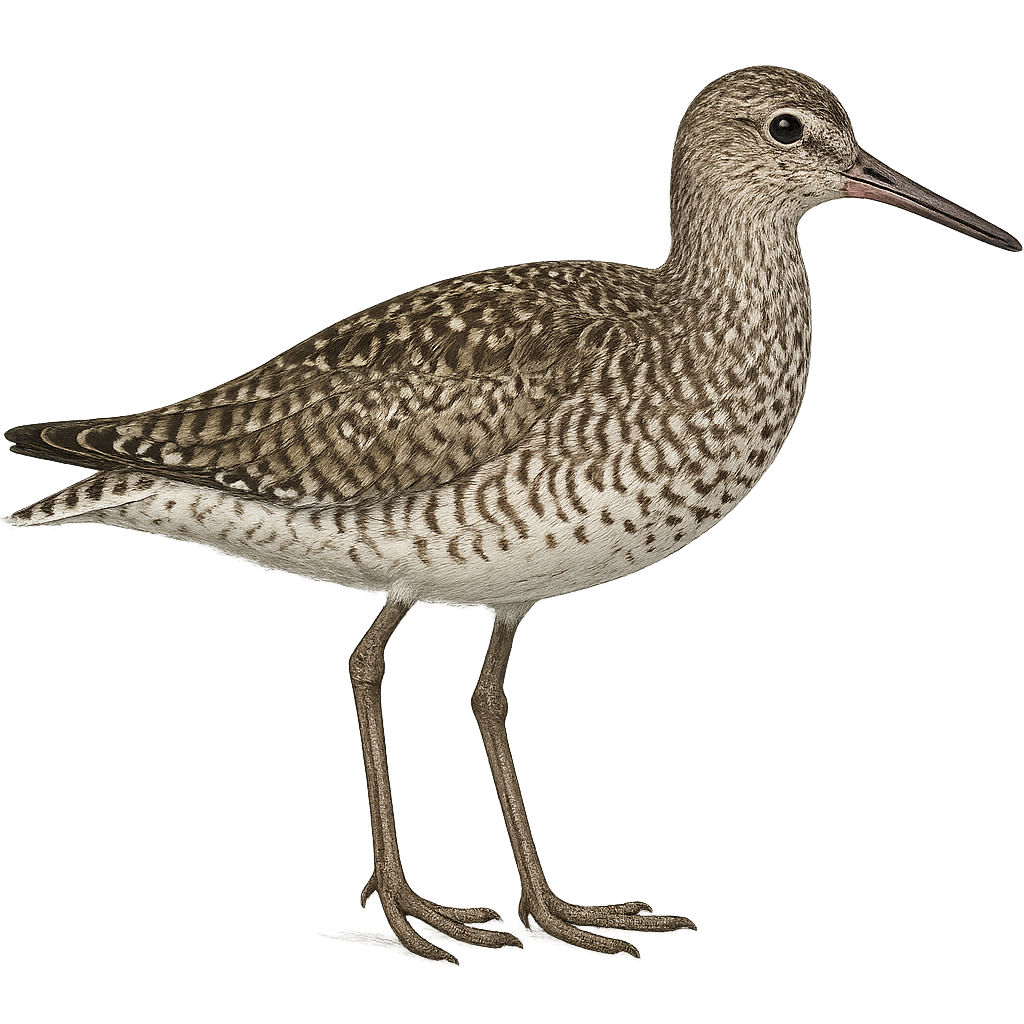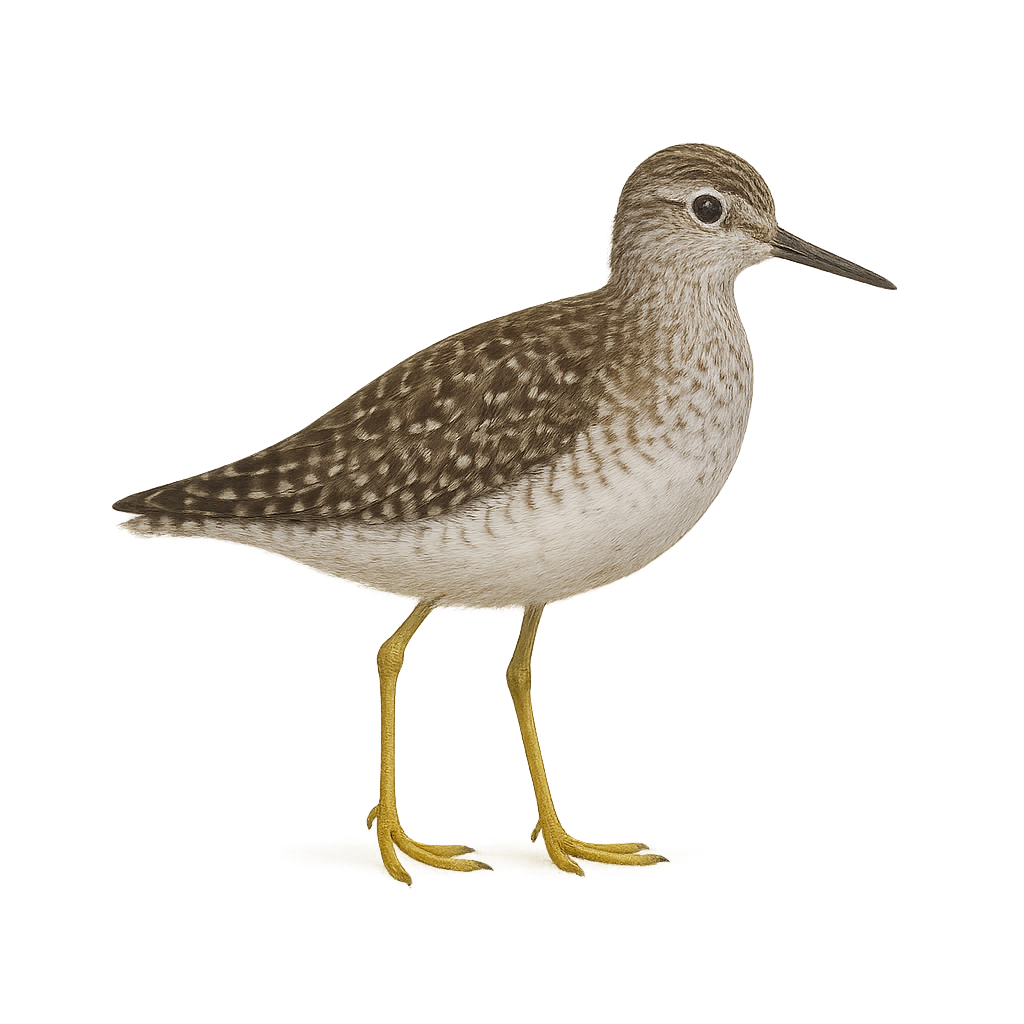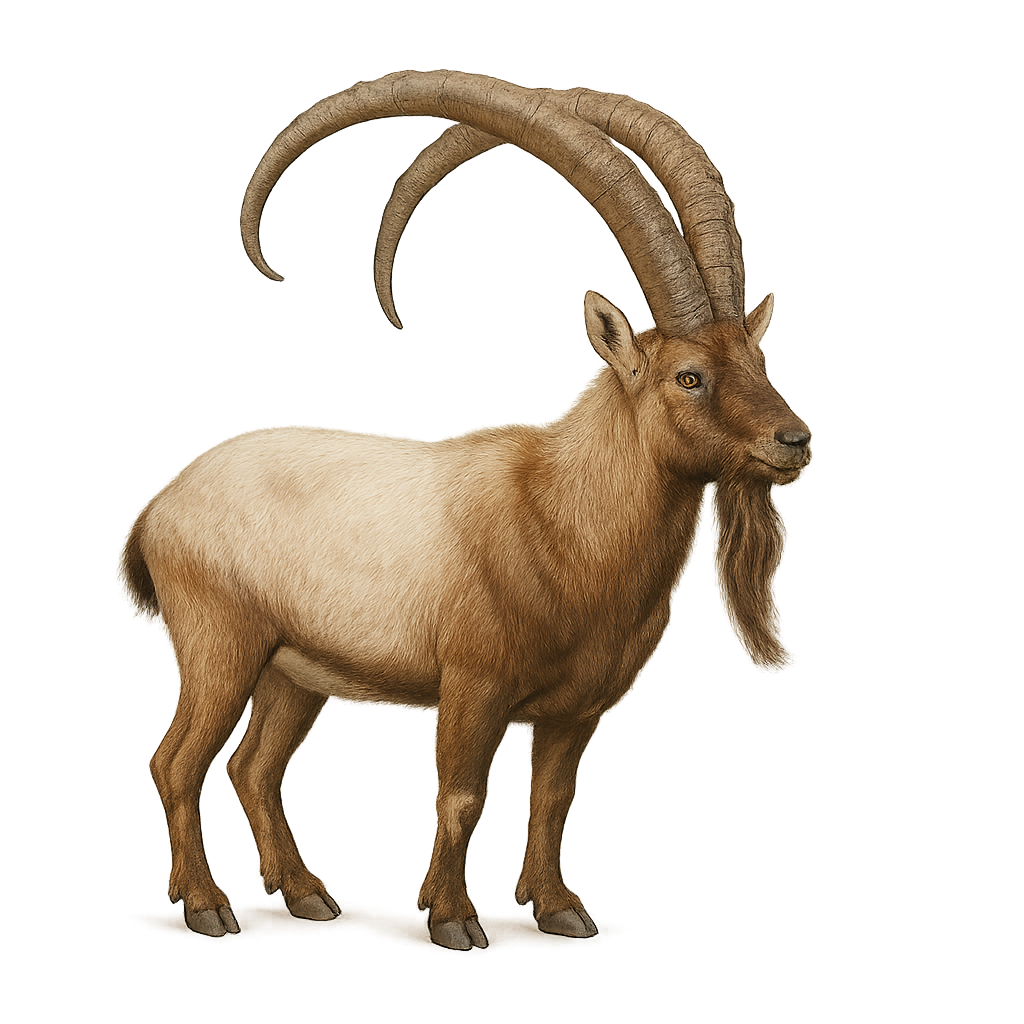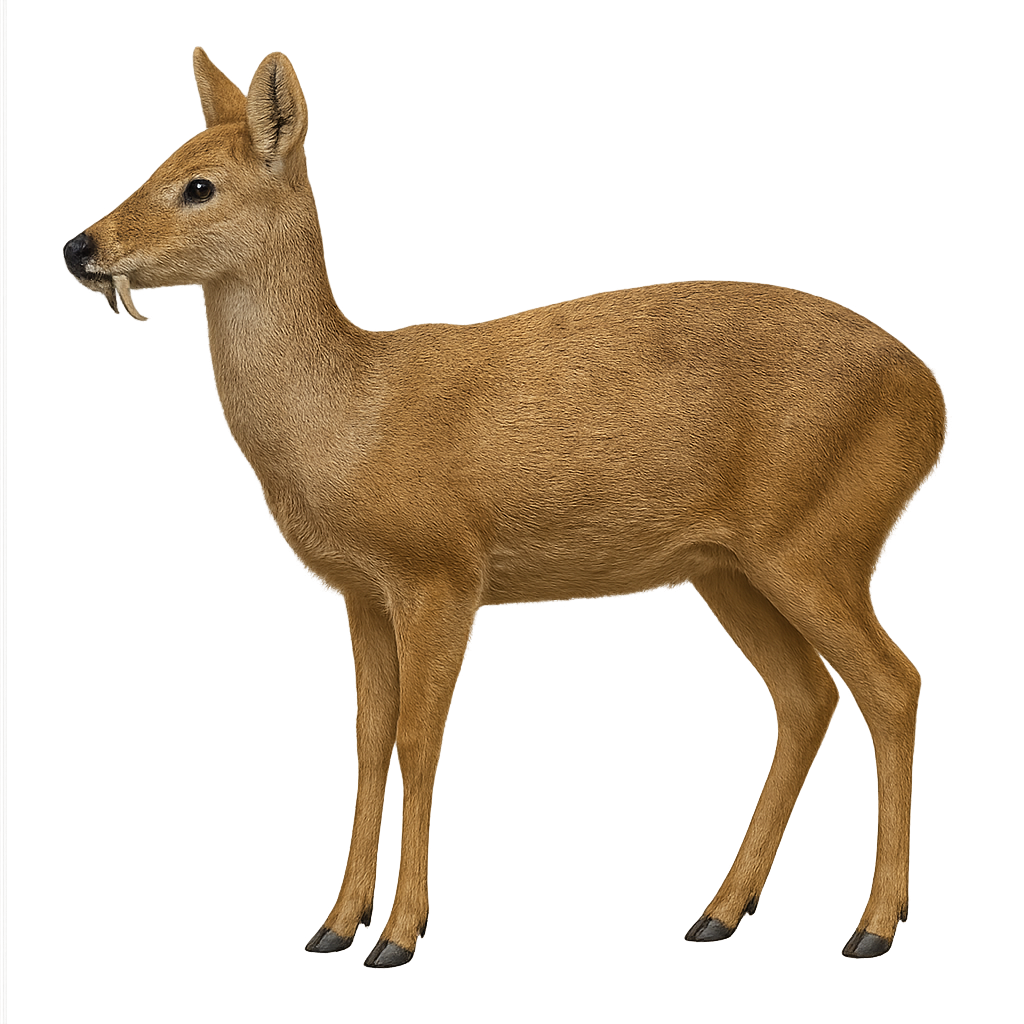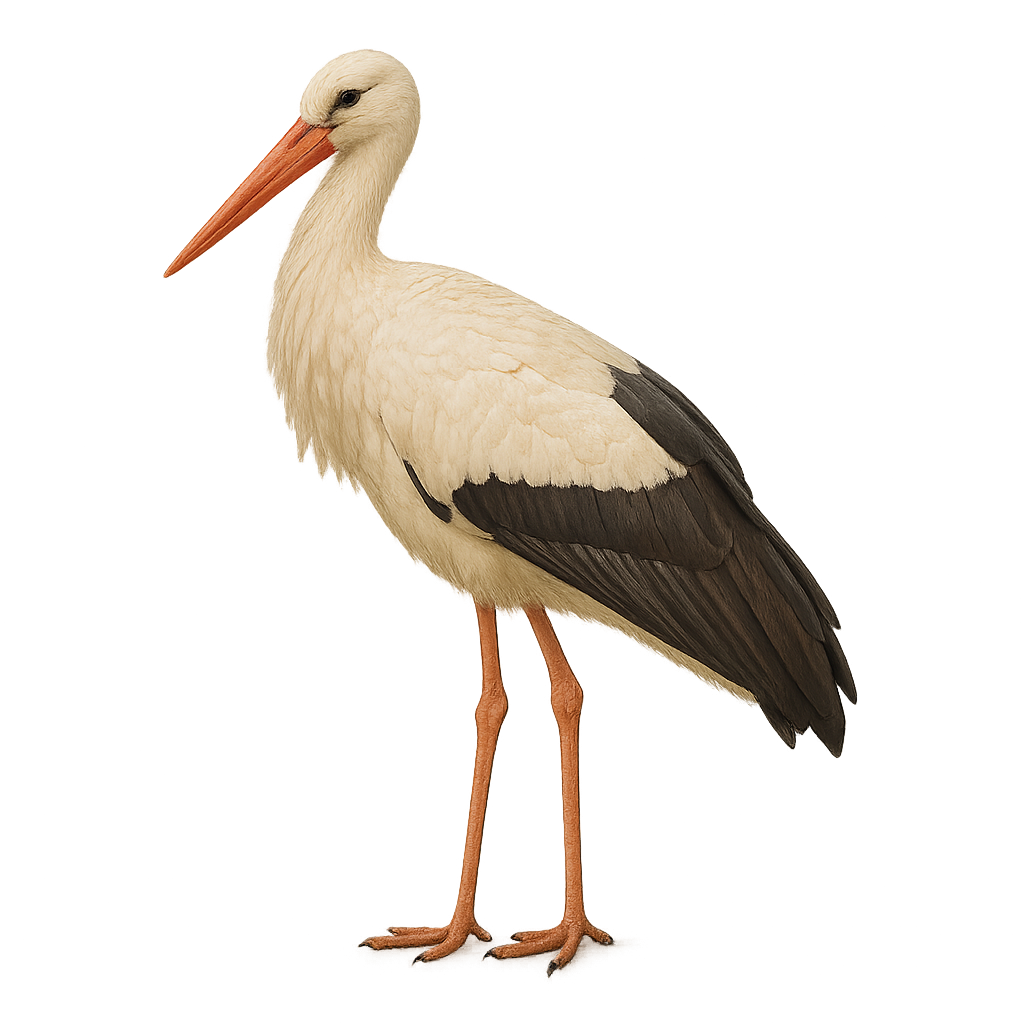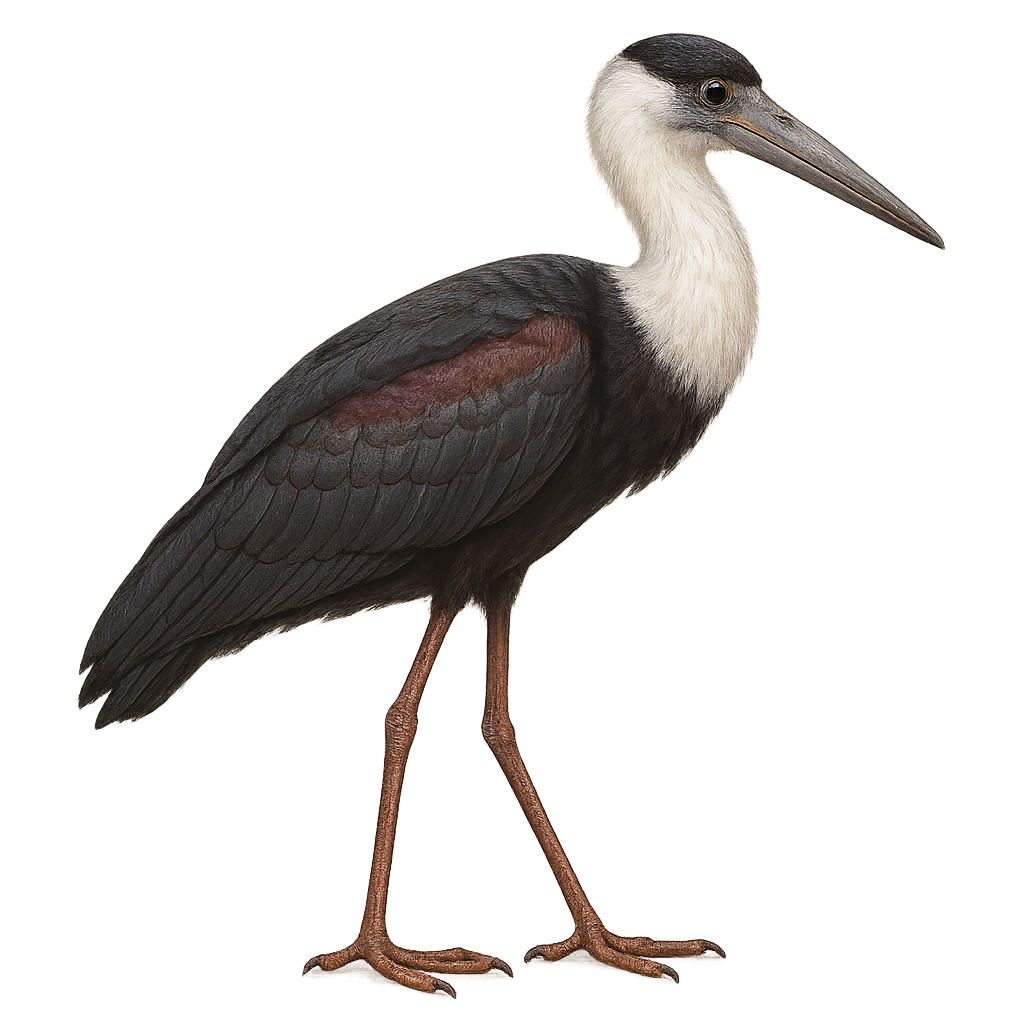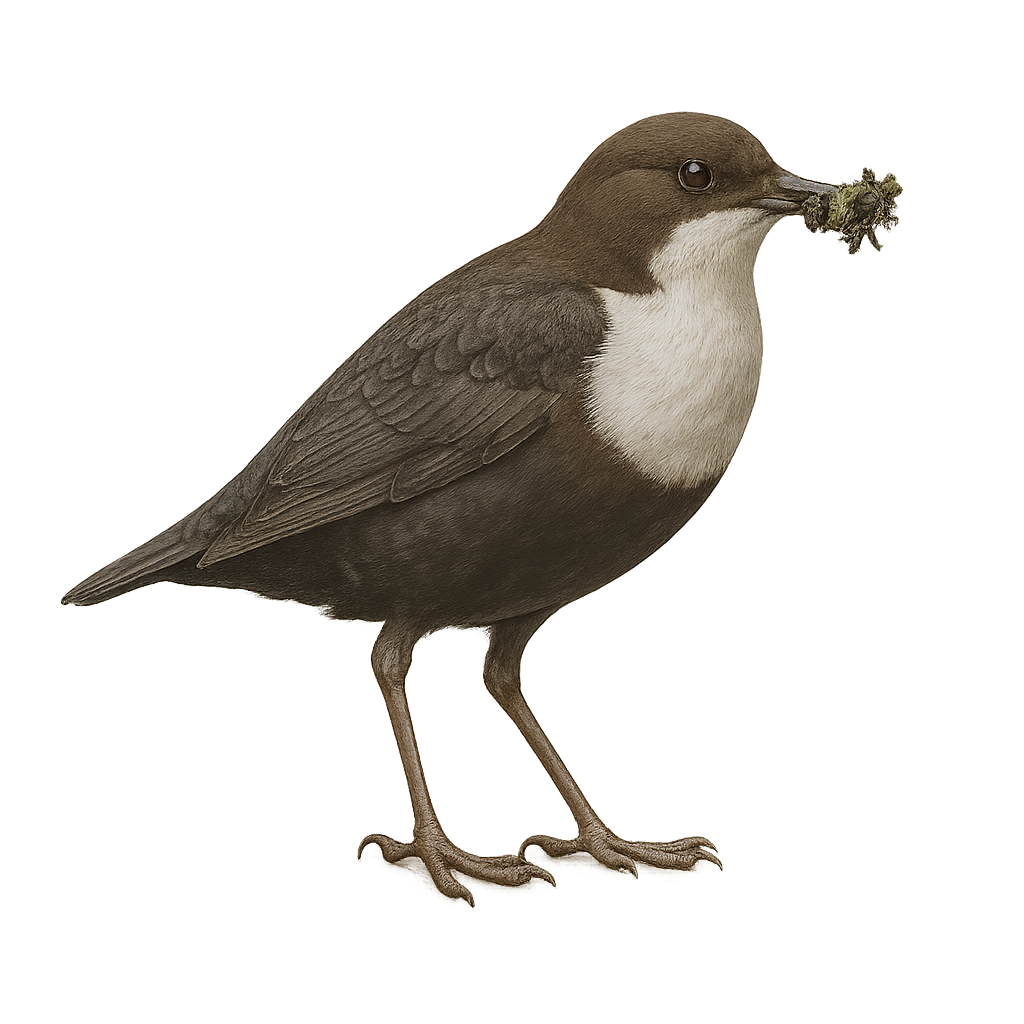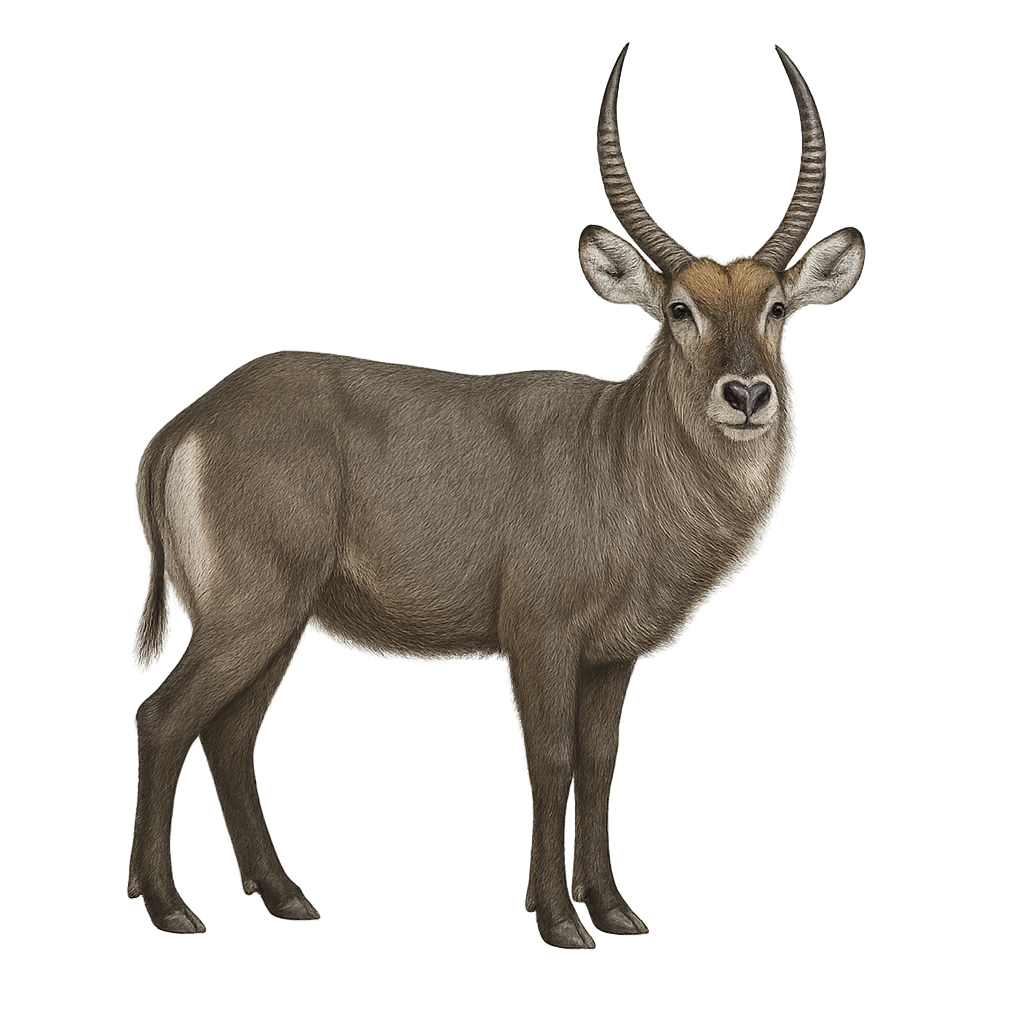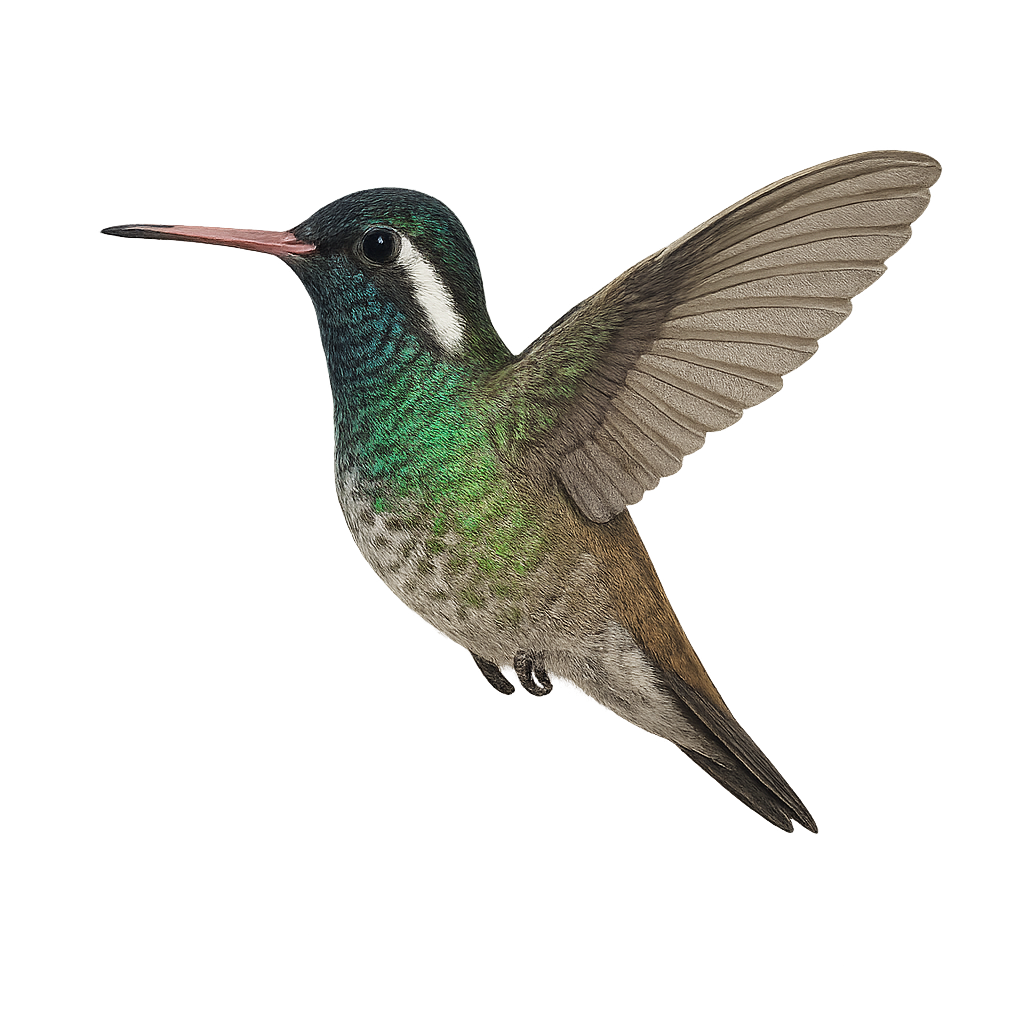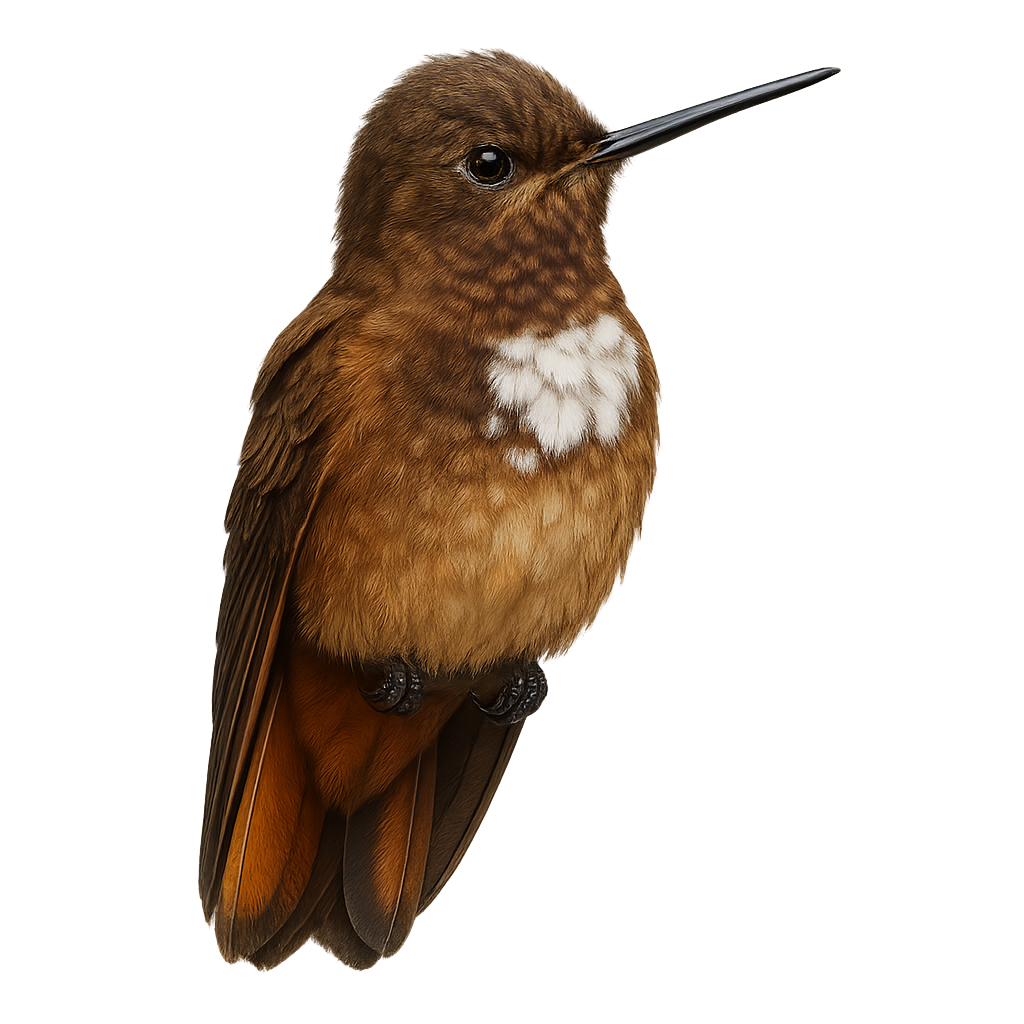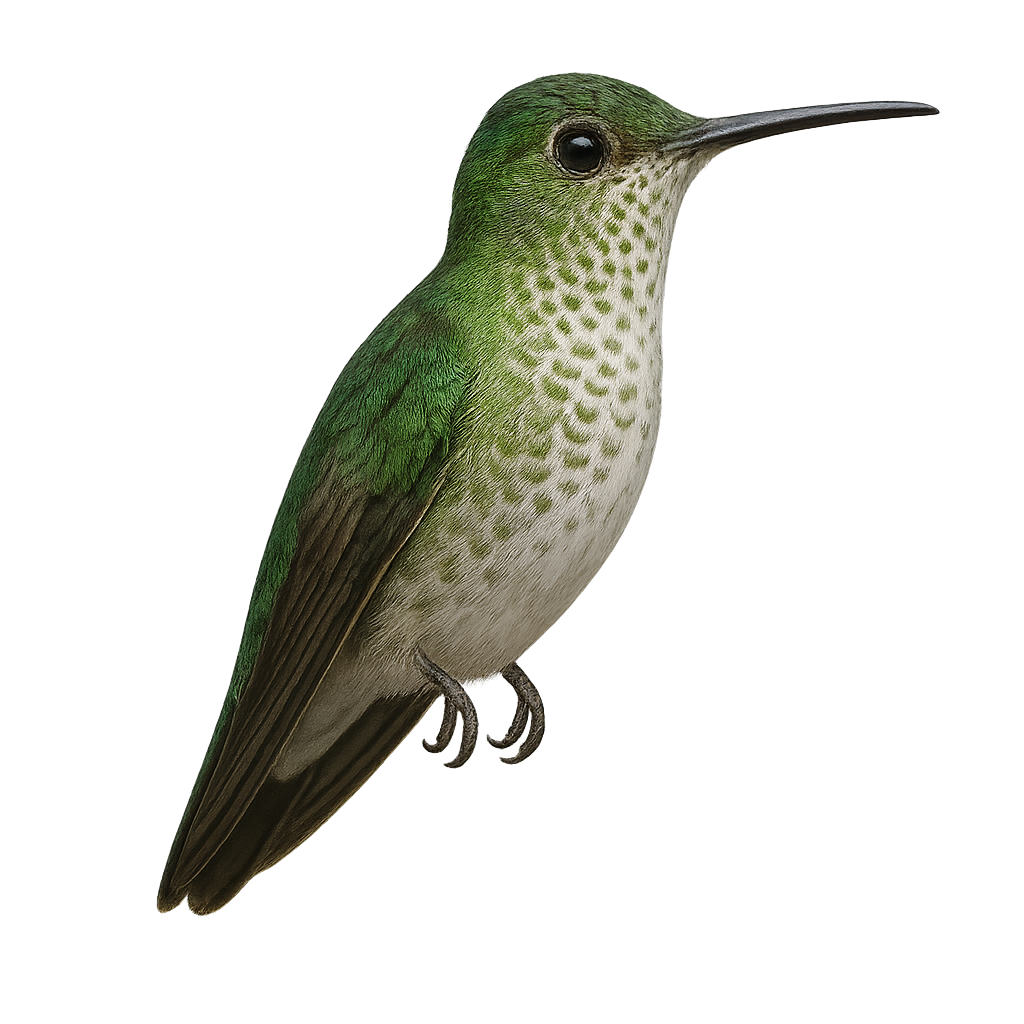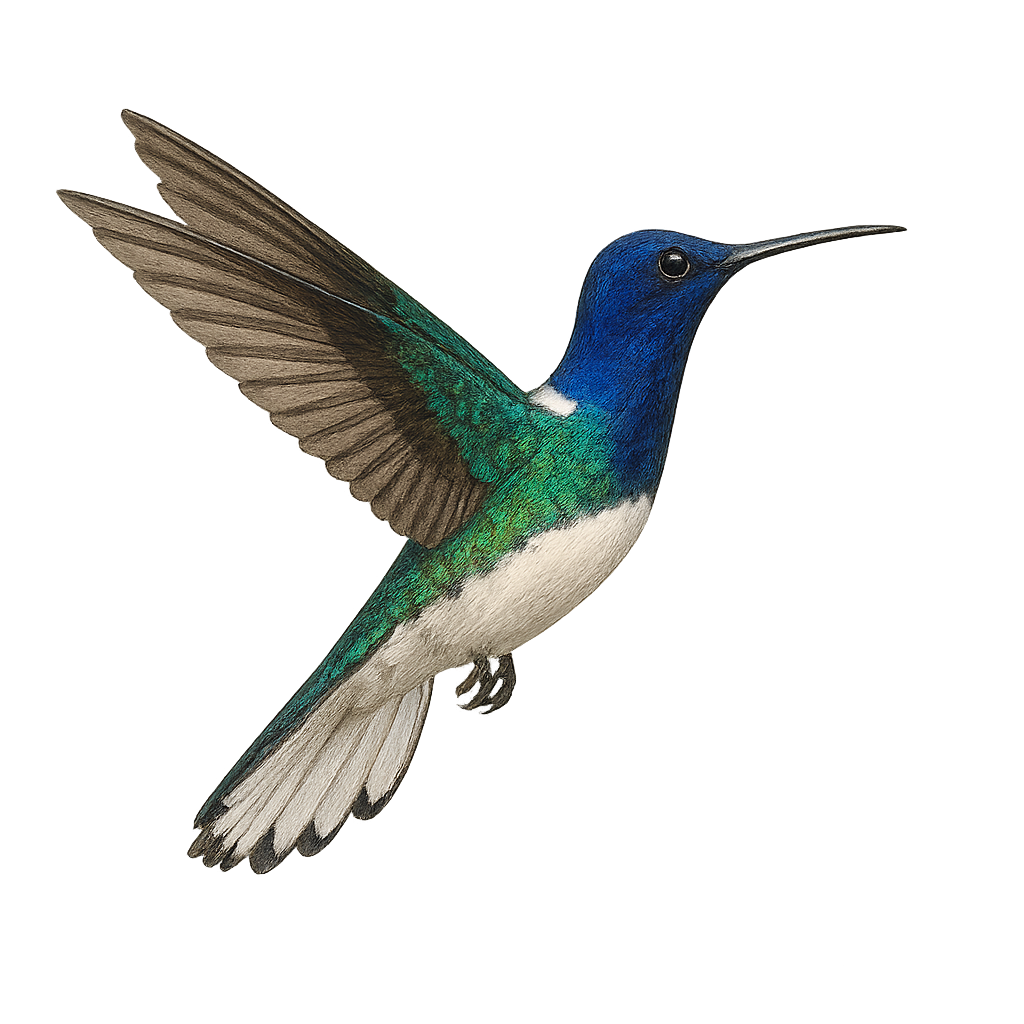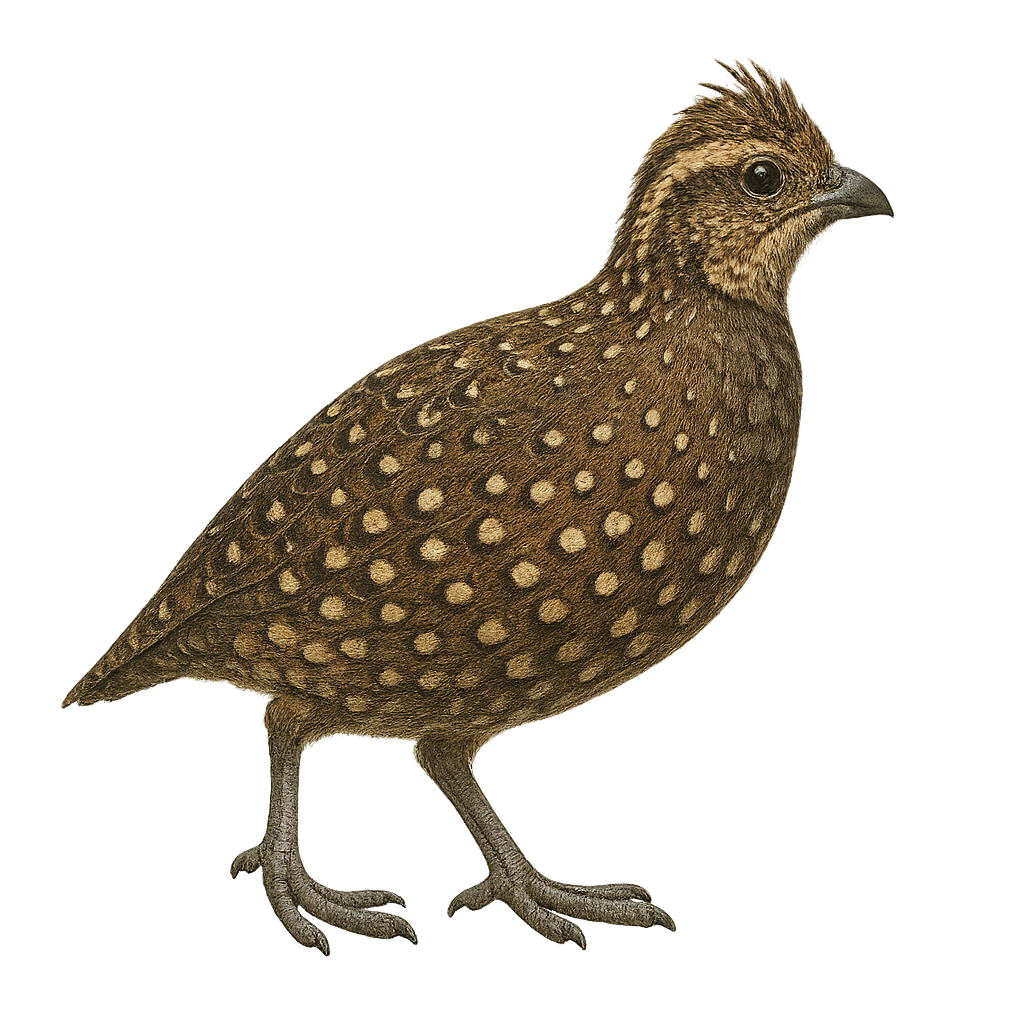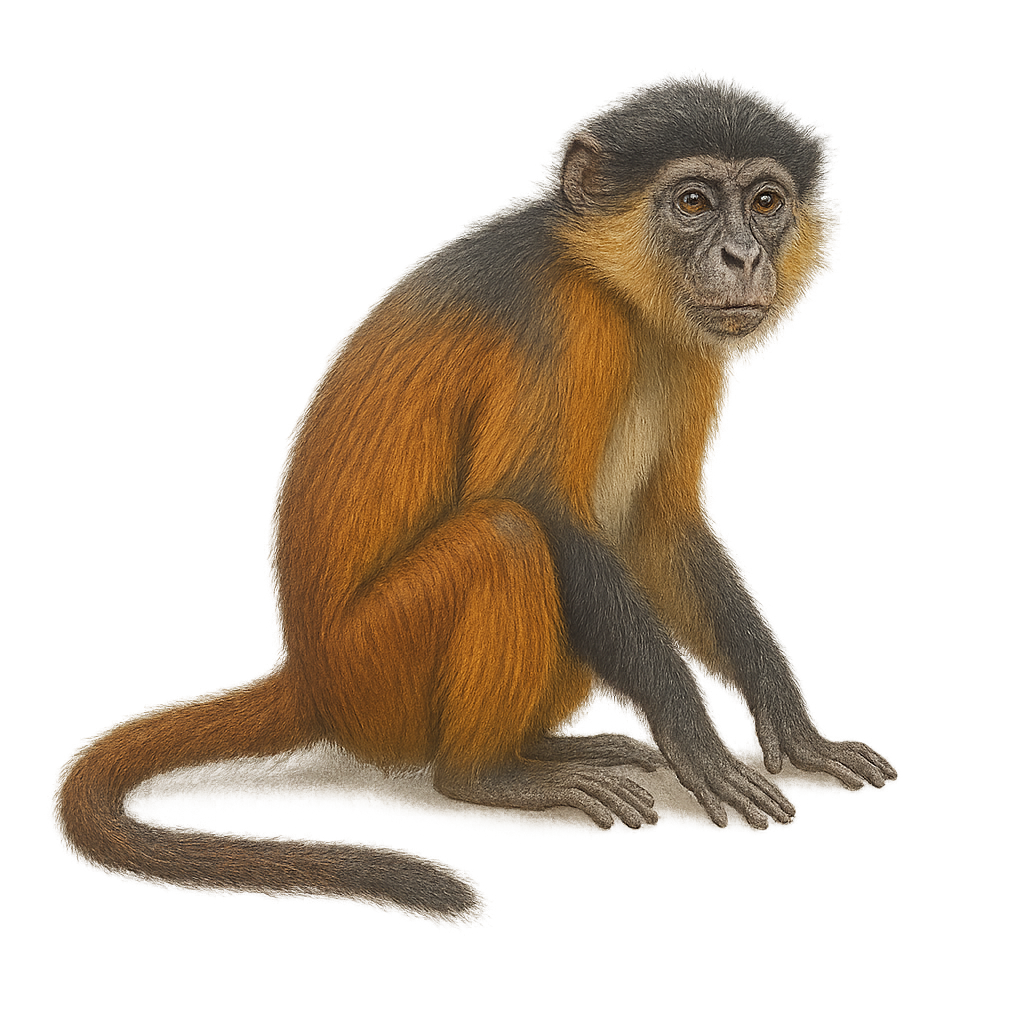The Furcifer verrucosus, or warty chameleon, is a species of chameleon endemic to Madagascar. It is easily recognizable by its rough, warty skin, which gives it its name. This chameleon can reach a size of 23 to 25 cm, with a tail that represents about half of its total length. Its coloration varies from green to brown, with lighter or darker patterns depending on its mood or environment. It primarily inhabits the dry forests and shrublands of the island. Like most chameleons, it has independent eyes that allow it to scan its surroundings at 360 degrees. It mainly feeds on insects, which it captures with its extendable tongue.
The White-winged Duck, Asarcornis scutulata, is a rare and endangered species in the Anatidae family. It is notable for its dark plumage with striking white wings visible in flight. Primarily nocturnal, it inhabits dense forests and wetlands in Southeast Asia. Its population is declining due to habitat loss and hunting. This duck is often solitary or found in small groups. It feeds on aquatic plants, insects, and small fish. Conservation of its natural habitat is crucial for its survival, with protection efforts including the establishment of nature reserves and awareness programs.
The Wood Duck, Aix sponsa, is a striking waterfowl known for its vibrant plumage and unique habits. The male displays bright colors with an iridescent green head, red eyes, and distinctive white patterns, while the female has a more subdued brown-gray plumage with white eye markings. Found primarily in North America, this duck frequents wooded areas near lakes, rivers, and swamps. It is known for its ability to nest in trees, often using natural cavities or artificial nest boxes. The Wood Duck is an excellent swimmer and diver, feeding on aquatic plants, insects, and small fish.
The White-cheeked Pintail, or Anas bahamensis, is a medium-sized duck known for its distinctive white head with a red spot on the bill and speckled brown plumage. It inhabits wetlands in the Caribbean, South America, and the Galápagos. Preferring shallow waters, it feeds on aquatic plants, insects, and small crustaceans. Often seen in small groups or pairs, this duck has a fast, direct flight but spends much time swimming and dabbling. Its population is stable, though habitat loss and hunting pose threats.
The white-faced capuchin, Cebus capucinus, is a New World monkey known for its pale face contrasting with its dark body. It primarily inhabits the tropical rainforests of Central America, from Honduras to Panama. Agile and intelligent, it uses tools for feeding and engages in social interactions within hierarchical groups. Omnivorous, it consumes fruits, insects, small vertebrates, and occasionally bird eggs. Its ecological role is crucial, particularly in seed dispersal. Although adaptable, deforestation threatens its habitat. Its complex communication includes varied vocalizations and facial expressions.
The White-faced Capuchin is a small, intelligent, and social monkey, easily recognizable by its pale face, framed by darker fur, and its agile, slender body. This primate lives in the tropical forests of Central and South America, primarily inhabiting the canopy, where it feeds on fruits, seeds, insects, and occasionally small vertebrates.
White-faced Capuchins are highly social animals, living in family groups or bands of up to twenty individuals. They are known for their great learning ability and curious behavior, often used in behavioral studies due to their intelligence and problem-solving skills. Unfortunately, like many other primate species, they are threatened by deforestation and habitat loss.
The Cebus albifrons, or white-fronted capuchin, is a New World monkey found in the tropical forests of South America. It is easily recognized by its light brown fur and distinctive white face. These primates are highly social, living in groups of up to 30 individuals. They are omnivorous, feeding on fruits, insects, small vertebrates, and occasionally leaves. Their intelligence is remarkable, and they use tools to access food. Although primarily arboreal, they sometimes descend to the ground to forage. Their habitat is threatened by deforestation, impacting their population.
The water chevrotain, or Hyemoschus aquaticus, is a small, elusive mammal primarily inhabiting the tropical forests of West and Central Africa. This ruminant, belonging to the Tragulidae family, is often mistaken for a small deer due to its appearance. It has a brown coat with white spots, allowing it to blend seamlessly into its environment. Measuring about 80 cm in length and weighing between 7 and 16 kg, it is well-adapted to a semi-aquatic lifestyle, often seeking refuge in water to escape predators. Nocturnal and solitary, it feeds mainly on fruits, leaves, and young shoots.
The Weyns's Duiker is a small, elusive antelope native to the dense forests of Central Africa. It is characterized by its reddish-brown coat and short, straight horns. This mammal is typically solitary, although it can sometimes be seen in small family groups. It primarily feeds on leaves, fruits, and young shoots, playing a crucial role in seed dispersal. Its ability to move silently through dense vegetation makes it a challenging animal to spot in its natural habitat. Although not currently endangered, deforestation and hunting pose potential threats to its long-term survival.
The white-tailed deer, or Odocoileus virginianus, is a widespread cervid in North and South America. It is easily recognizable by its white tail, which it raises when alarmed. Males have antlers that they shed annually. The coat varies from reddish-brown in summer to gray-brown in winter, providing excellent camouflage. This deer is highly adaptable, living in various habitats from dense forests to open grasslands. It is primarily herbivorous, feeding on leaves, fruits, and young shoots. The white-tailed deer plays a crucial role in its ecosystem, influencing vegetation and serving as prey for many predators.
The Greenshank is a large species of wader, distinguished by its long bill and slender legs. It has a gray-brown plumage marked with lighter spots and a slightly speckled head, which helps it blend into the muddy and marshy environments of wetlands and shorelines. This wader is especially known for its characteristic calls, a loud barking cry, which is how it gets its name. It primarily inhabits wetlands, estuaries, and shorelines where it feeds on small invertebrates, worms, and crustaceans found by probing in the mud.
The Greenshank is a migratory bird that travels long distances between its breeding grounds in Europe and its wintering sites in Africa and Asia. Although its population remains relatively stable, it faces threats from the loss of wetland habitats and pollution. The species is protected in some areas where it is found.
The Wandering Tattler, Tringa incana, is a medium-sized shorebird, measuring about 25 to 27 cm in length with a wingspan of 50 to 60 cm. Its plumage is primarily gray with lighter shades on the belly and dark barring on the chest. The legs are yellow, and the bill is straight and relatively long, adapted for foraging in coastal areas. This bird is often seen moving quickly along rocky shores, searching for small invertebrates and crustaceans. A migratory species, it breeds in Arctic regions and migrates to Pacific coasts during the winter.
The Willet is a medium-sized bird belonging to the Scolopacidae family. It is characterized by its long legs and straight, sturdy bill. Its plumage is primarily gray-brown with lighter patterns on the belly. In flight, its wings reveal a distinctive white band. This bird mainly inhabits wetlands, beaches, and coastal marshes. It is often seen probing the ground for small invertebrates, crustaceans, and mollusks. Although generally solitary, it can form small groups during migration. The Willet is a partial migrant, breeding in northern regions and wintering further south.
The Wood Sandpiper is a medium-sized wader, recognizable by its elegant plumage that ranges from gray-green to white, with dark markings on the wings and sometimes a marbled head. This wader is primarily found in wet forests and marshy areas, where it feeds on small invertebrates, worms, and occasionally small fish, which it catches by probing in the mud and shallow water.
During the breeding season, the male displays brighter colors, notably a darker head plumage and iridescent green shades on its back. Outside the breeding season, the Wood Sandpiper has a more subdued and uniform plumage, often gray-brown. As a migratory bird, it travels between its breeding grounds in Northern Europe and its wintering sites in Africa and Asia. Although its population remains relatively stable, the Wood Sandpiper faces threats from the loss of wetland habitats and pollution.
The wild goat, or Capra aegagrus, is a robust and agile animal native to the mountains of Western Asia. It is the ancestor of the domestic goat and is distinguished by its impressive, curved horns, especially prominent in males. Its coat ranges from brown to gray, providing excellent camouflage in its rocky habitat. Wild goats live in groups, often consisting of females and young, while adult males are more solitary. They are well adapted to rugged terrains and can climb with remarkable agility. Their diet mainly consists of mountain vegetation, making them dependent on climatic conditions and the availability of natural resources.
The water deer is a small semi-aquatic deer, 45–55 cm at the shoulder, with tawny fur and an elongated muzzle. Native to China and Korea and introduced in parts of Europe, it inhabits marshes, rivers, and wetlands, feeding on aquatic plants, grasses, and riparian thickets. Solitary and crepuscular, it often moves under vegetative cover.
The White-billed Starling is a medium-sized bird, easily recognizable by its glossy black plumage and distinctive white bill. It is primarily found in the mountainous regions of Ethiopia and Eritrea. This bird is often seen in small groups, feeding on fruits, insects, and sometimes small vertebrates. Its song is melodious, consisting of whistles and trills. It plays a crucial role in seed dispersal, aiding forest regeneration. Although relatively common in its natural habitat, it is threatened by deforestation and habitat loss.
The western jackdaw is a 34–39 cm corvid with dark slate-grey plumage and a black cap, notable for its pale, piercing eyes. Found throughout Europe and western Asia, it inhabits urban areas, coastal cliffs and open countryside, feeding on insects, seeds, small invertebrates and eggs. An opportunistic omnivore, it nests in natural or built cavities and may form large colonies.
The White Stork is a large bird easily recognized by its slender silhouette, bright white plumage, and long red legs. It has a long pointed beak, which it primarily uses to capture prey in wetlands, meadows, and fields. This migratory bird travels thousands of kilometers each year, migrating from Eastern and Central Europe to Africa for the winter.
The White Stork primarily feeds on small mammals, amphibians, insects, and small birds, which it captures with its great ability to walk and forage through grass or mud. While it is a solitary bird during breeding, it gathers in large colonies during migrations. Although its population remains stable in many parts of Europe, it faces threats from habitat loss, hunting, and human disturbances. Conservation efforts are underway to protect this iconic species.
The Woolly-necked Stork, or Ciconia episcopus, is a majestic and imposing bird, easily recognizable by its distinctive black and white plumage and woolly neck. It primarily inhabits wetlands, marshes, and rivers in South and Southeast Asia, as well as some regions of Africa. Measuring between 80 and 94 cm in height, it has a long, pointed beak, ideal for capturing its food, which mainly consists of fish, amphibians, and insects. Although often solitary, it can be observed in small groups during the breeding season. The Woolly-necked Stork is a diurnal bird, active mainly during the day, and is known for its ability to cover long distances in flight.
The White-throated Dipper is a small aquatic bird, easily recognized by its dark plumage, compact body, and characteristic posture, often seen bobbing on rocks at the edge of streams. It has brownish plumage on its back and a white chest, with a short, powerful beak. This small bird is perfectly adapted to aquatic life, thanks to its webbed feet that allow it to swim and dive underwater in search of food.
The White-throated Dipper primarily feeds on aquatic insects, larvae, and small fish, which it captures by diving into rivers and streams. It is capable of swimming underwater and moving along the riverbed to search for prey. Although this bird is generally solitary, it can be observed in clear river or stream habitats, primarily in Europe and Asia. While it is generally not threatened, it can be impacted by water pollution and the disruption of its natural habitats.
The White-bellied Cinclodes is a medium-sized bird, easily identified by its dark brown plumage contrasting with its pure white belly. It primarily inhabits Andean regions, feeding on insects and small invertebrates found by probing the ground with its slender, slightly curved beak. This bird is often seen near streams or in wet grasslands, moving with agility. Although relatively tolerant of human presence, it prefers less frequented areas. Its song is a melodious trill that echoes through the mountains, adding a musical touch to its natural surroundings.
The White-nosed Coati is a mammal from the raccoon family, easily recognized by its distinctive white snout that contrasts with its reddish-brown fur. It has a long, ringed tail that it uses to maintain balance while moving through trees. This small carnivore is primarily found in the tropical and subtropical forests of Central America, Mexico, and the southern Costa Rica, where it lives in social groups, often led by a dominant female.
Omnivorous, the White-nosed Coati feeds on fruits, insects, small vertebrates, eggs, and even small mammals. Its social lifestyle is marked by complex interactions within its family groups. Although its population remains relatively stable in certain protected areas, it is still threatened by deforestation, hunting, and habitat disruption. Conservation efforts aim to protect the forest areas of this agile and adaptable animal.
The waterbuck, or Kobus ellipsiprymnus, is a large African herbivore known for its grayish-brown coat and distinctive white ring on its rump. It primarily inhabits wet savannas and grasslands near water bodies, as it relies on water for survival. Males have long, curved horns, while females lack them. This gregarious mammal forms mixed herds, although adult males are often solitary or in small groups. The waterbuck is an excellent swimmer, allowing it to escape predators. Its diet mainly consists of grasses and aquatic plants.
The White-eared Hummingbird is a small, captivating bird primarily found in the pine and oak forests of Mexico and Central America. It is distinguished by its characteristic white ears, contrasting with its metallic green plumage. This hummingbird measures about 9 to 10 cm in length and weighs between 3 and 4 grams. It primarily feeds on nectar but also consumes small insects to supplement its diet. Its flight is fast and agile, allowing it to maneuver easily among flowers. The White-eared Hummingbird is often observed alone or in small groups, and it vigorously defends its feeding territory against intruders.
The White-tufted Sunbeam, or Aglaeactis castelnaudii, is a fascinating bird from the Trochilidae family. This hummingbird is distinguished by its brilliant plumage, with metallic green hues and a characteristic white patch on its chest. It is mainly observed in the Peruvian Andes, where it frequents humid forests and shrublands at high altitudes. This hummingbird is an essential pollinator, feeding on flower nectar with its long adapted beak. Its small size and rapid flight make it difficult to observe, but its ecological role is crucial for the pollination of Andean plants. Although its conservation status is concerning, efforts are underway to protect its natural habitat.
The White-bellied Hummingbird, or Taphrospilus hypost, is a small, fascinating bird from the Trochilidae family. This hummingbird is primarily found in the humid forests and wooded areas of the Andes, where it feeds on flower nectar with its long, slender beak. Its plumage is mainly emerald green with a distinctive white belly, making it easily identifiable. Males and females share similar characteristics, although males may have slightly brighter colors. This hummingbird is known for its fast and agile flight, often accompanied by characteristic buzzing sounds. It plays a crucial role in the pollination of local plants.
The White-necked Jacobin, or Florisuga mellivora, is a bird from the Trochilidae family, easily recognizable by its striking plumage. The male boasts a bright blue head and neck, contrasting with a white chest and metallic green back. The female, on the other hand, has a duller plumage with shades of green and blue. This hummingbird is mainly found in the humid tropical forests of Central and South America, where it feeds on nectar and insects. Its fast and agile flight allows it to move easily between flowers. The White-necked Jacobin plays a crucial role in plant pollination, thus contributing to the biodiversity of its habitat.
The White-throated Quail-Dove, Colinus leucopogon, is a bird from the Odontophoridae family. It is mainly found in mountainous regions of Mexico and Central America. This bird is characterized by its white throat contrasting with its dark brown plumage. It prefers dense forests and wooded areas where it can easily hide from predators. The White-throated Quail-Dove is a terrestrial bird that feeds mainly on seeds, fruits, and insects. It is often seen in small groups or pairs. Although relatively discreet, its melodious song can be heard throughout the forest. Its population is stable, but deforestation poses a potential threat to its natural habitat.
The Western Red Colobus, or Piliocolobus badius, is an arboreal primate found mainly in the forests of West Africa. Recognizable by its reddish fur and black face, it is a social animal living in groups of up to 80 individuals. These monkeys primarily feed on leaves, but also consume fruits and flowers. Their specialized diet makes them vulnerable to deforestation and habitat loss. The Western Red Colobus is also known for its complex vocalizations used for group communication. Unfortunately, this species is threatened by hunting and habitat destruction, leading to a significant population decline in recent decades.


